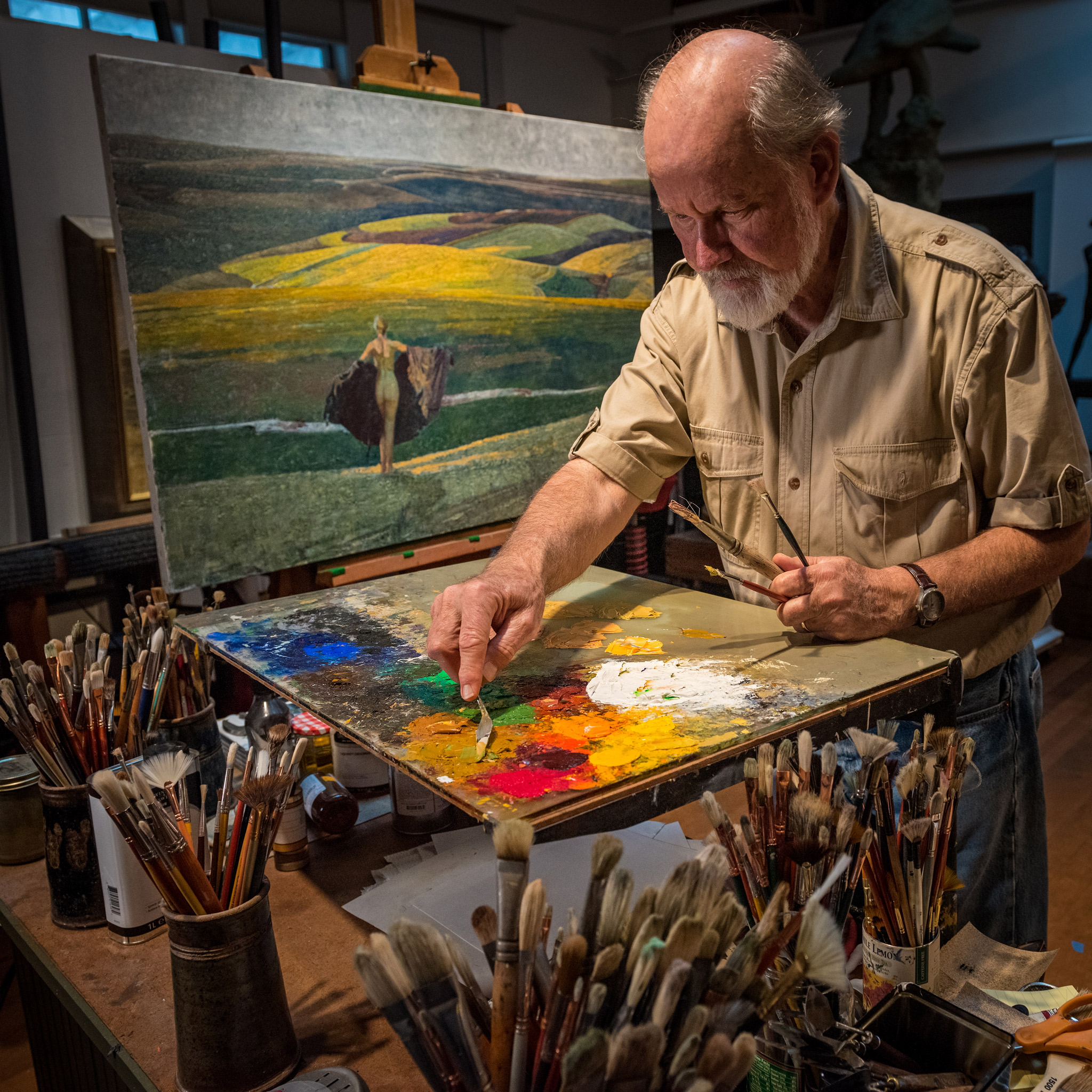“To this day, I have this thing about life. I want to get the vitality of life, whatever way I can do it, into the work.”
As I sit with renowned nature artist George Carlson in his studio, I realize these are more than just words for the painter and sculptor. The pursuit of life’s essence has been his guide for nearly all of his eight decades, and has so woven itself into his work that George’s art has truly become a reflection of himself.
Now living on 55 beautiful acres just outside of Harrison, Idaho, George and his wife Pamela are able to enjoy the peaceful vitality of trees and wildlife by just walking out their front door. Having reached a point in his life where he often finds himself reflecting, George says he feels immense gratitude for the life he’s lived.
And what a life he has lived.
Fascinated with art and observing the world around him since he was a boy, George learned how to transfer what he saw onto canvas and three-dimensional mediums through schooling at the Chicago American Academy of Art, the Art Institute of Chicago, and the University of Arizona. He attributes much of his formative artistic influences to the early encouragement of his mother, as well as to mentors Glen Messersmith and Ralph Thompson in his high school and college years.
It was when George decided to leave Chicago in his 20s that he discovered the first of his major artistic passions. He’d had a job doing commercial illustration for a time, but tired quickly of its creative limitations and headed west to Winter Park, Colo. His father didn’t understand George’s desire to exchange paintbrushes for ski poles, but George felt the need to purify himself. He took two years off of art, doing whatever work came his way and gradually developing an intense interest in American Indian culture.
George has always believed in learning as much as possible about anything that catches his interest, and so fully immersed himself in studying the local tribes’ history, religion and way of life. Where Western art had predominantly featured images such as cowboys and American Indians shooting buffalo from horseback, George perceived a far deeper expression of cultural identity in their daily lives and spirituality. He recognized that a unique trust was being extended in allowing him to witness some of their traditions, and always made a point to be respectful in what he expressed through his art.

An aspect of American Indian culture that he brought to life in several of his sculptures was their reverence for the natural world and the spirituality behind it. One such example in bronze that earned him the prestigious Prix de West medal in 1975 was Courtship Flight, which featured two eagles in mid-air with talons interlocked.
After about 10 years spent learning from American Indians, George heard of a new potential artistic opportunity from his friend, Dick Spas. Dick had been doing landscape photography in Mexico and told George about a tribe of natives called the Tarahumara in the Sierra Madres Mountains who were virtually untouched by the outside world. Profoundly intrigued, this tip soon had George driving up rivers, along rustic dirt roads where one could go 10 hours to traverse only 45 miles, and into an ancient world that required all the patience and power of observation he’d been developing since childhood.
Story continues after a quick message from our sponsor below.
“I think that’s where my bird-watching came in handy, because I have a lot of patience,” he says. “When I see something and know I want to do it, I’m not going to rush it.”
This ability proved vital to his success with the illusive Tarahumara, as did his luck in having young Mario Parra as his guide and translator, who himself was part-Mexican, part-Tarahumaran.
For weeks, George painted only landscapes, respectfully allowing time to build relationships and trust. When he started working with models, he found he had volunteers of all ages. He strove to portray the strength of the Tarahumaran features in his sculptures and paintings, as well as the pride they took in their ceremonies and the overall beauty of their simple lives.
The Tarahumara were George’s primary inspiration for about 15 years until he began to feel drawn in a different direction. He was living in Elizabeth, Colo. at the time, and while attending horse pulls in the area, became fascinated with draft horses. The ranchers talked about how the most important quality in a team was “having heart,” or the ability to pull together with all their strength.
“I just love the volume,” George says. “You have to really feel that volume because for me that was sculpture.”
He spent about 10 years studying these magnificent beasts, seeking to encapsulate their intrinsic beauty and immense power in his works. One of George’s bronzes, named Searching the Wind, he did based off an incident he witnessed where a spunky stallion wouldn’t let a rancher put a collar over his head. Exasperated, the man finally took off his sweatshirt and wrapped it around the horse’s head. George was stunned as the massive animal instantly froze, its statuesque body still pulsing with 2,000 pounds of sheer power.

George explained that many of his pieces often become a metaphor for what he sees going on in the world around him.
“When I review the bigger picture about what I’m trying to express in different works, it’s for the work to transcend … no matter what the subject … into a metaphor about the human condition,” he says ”Searching The Wind is one of these works. It is about the message of losing some of our natural instincts to technological dependencies.”
It likely surprised many following George’s career when he then turned to ballerinas. His wife had studied ballet, and when chance provided them the seasonal use of a New York City apartment, he had the perfect opportunity to study some of the best dancers.
“The challenge for me was to go from doing large, massive draft horses, to these thin, willowy, lithe dancers,” he says.
Despite the jolting shift in artistic subjects, he saw the same essence of life in both the draft horse and ballerina, as contrasting as their physical forms might be.
George was granted the privilege of sitting in on classes at the School of American Ballet, where he was able to observe until a dancer’s particular movement caught his attention.
“Anything I do, I don’t go in with a judgment,” he says. “I go in more with being a channel, letting it come through you.”
After 30 years of doing primarily figurative sculpture, George felt the draw to return his focus to painting. He felt called not to the scenery everyone recognizes, but to the unknown landscapes; to the rolling hills and forest trails one has to drive long hours and stop and listen to. He drew inspiration from Walt Whitman and other poets in how he saw the land, and even took to studying geology in order to better understand the physicality of what he was seeing.
George’s current muses have been the Palouse and Channeled Scablands of Eastern Washington. He earned his second Prix de West medal in 2011 for a painting set in the Scablands called Umatilla Rock, making him the only artist to receive two Prix de Wests in as many mediums.
His landscapes are rich in detail and color without being saturated with them, and are imbued with a life-like dimension that captivates the eye. For George, he sees the land embodying life in the rounded female forms of the Palouse loess hills, contrasted starkly with the jagged maleness of the Scablands.
What impresses me most about George is his commitment to his work and versatility; to his pursuit of life and the little pieces of magic that connect all facets of existence.
In whatever George sets his hands to, he has always pursued that elusive essence that gives life its meaning, and in doing so has found his bliss.
“It’s the interconnectedness of everything,” he says. “Dance isn’t separate from the draft horse or from the Indians or from the landscape; it’s all interconnected. If you take what it is today but then follow it back in its own history, you find that somewhere along the line it all intersects, and it all becomes one big beautiful.” N
By Abby Owens
Photography By Joel Riner




1 Comment
George Carlson is the greatest living artist – Artist – that I know of. Y’all should go back and document everything you can for as long as you can.